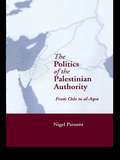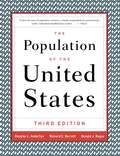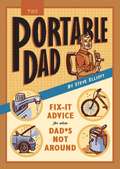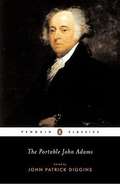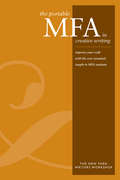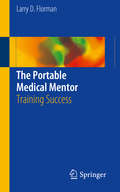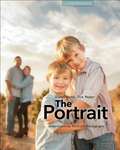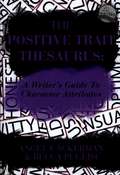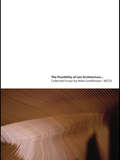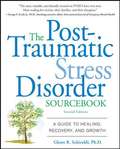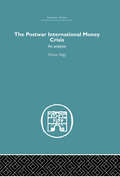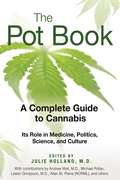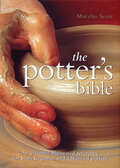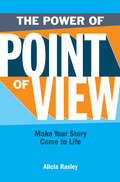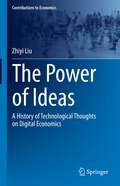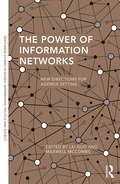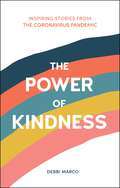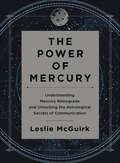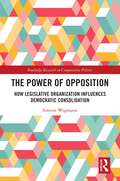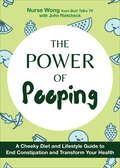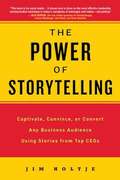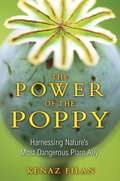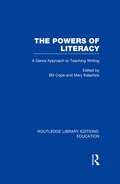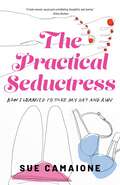- Table View
- List View
The Politics of the Palestinian Authority: From Oslo to Al-Aqsa
by Nigel ParsonsThis book explores the development of the Palestinian Liberation Organization (PLO) from a liberation movement to a national authority, the Palestinian National Authority (PNA). Based on intensive fieldwork in the West Bank, Gaza and Cairo, Nigel Parsons analyzes Palestinian internal politics and their institutional-building by looking at the development of the PLO. Drawing on interviews with leading figures in the PLO and the Palestinian Authority, delegates to the negotiations with Israel, and the Palestinian political opposition, it is a timely account of the Israel/Palestine conflict from a Palestinian political perspective.
The Population of the United States (3rd edition)
by Douglas L. Anderton Richard E. Barrett Donald J. BogueThis third edition, written with two new coauthors, combines 1990 census data with information from the Current Population Survey, the National Health Interview Survey, and numerous other sources, even including demographic data not available in any other published source.
The Portable Dad: Fix-It Advice for When Dad's Not Around
by Steve ElliottFor college students, twentysomethings, and anyone else who keeps Dad on speed-dial for car emergencies, plumbing woes, appliance advice, and more. Take Dad's know-how with you everywhere you go! This Dad's got all the answers to all the basics, so that you can get it done and move on. He knows how to hang, unclog, patch, drill, paint, mow, lube, edge, weed, sand, pack, and more. The Portable Dad is the answer to those panicked late-night phone calls: how to keep things running, how to maintain the stuff you use, how to get by without getting in over your head. If Dad doesn't know the answer, you don't really need to do it!
The Portable John Adams
by John Adams Jack DigginsIn addition to being an uncompromising defender of liberty, esteemed diplomat, and successor to George Washington, John Adams was a passionate and prolific writer. Adams biographer John Patrick Diggins gathers an impressive variety of his works in this compact, original volume, including parts of his diary and autobiography, and selections from his rich correspondence with this wife, Abigail, Thomas Jefferson, and others. The Portable John Adams also features his most important political works: "A Dissertation on Canon and Feudal Law," "Thoughts on Government," "A Defense of Constitutions," "Novanglus," and "Discources in Davila." There is no finer introduction to the protean genius of this seminal American philosopher. First time in Penguin Classics
The Portable MFA in Creative Writing: Improve Your Craft With The Core Essentials Taught To Mfa Students
by New York Writers WorkshopGet the core knowledge of a prestigious MFA education without the tuition. Have you always wanted to get an MFA, but couldn't because of the cost, time commitment, or admission requirements? Well now you can fulfill that dream without having to devote tons of money or time. The Portable MFA gives you all of the essential information you would learn in the MFA program in one book. Covering fiction, memoirs, personal essays, magazine articles, poetry, and playwriting, this book provides you with: Inspiration and tips on revision, stamina, and productivity Clear instruction on the craft behind the art Detailed reading lists to expand your literary horizons Exercises to improve your writing endeavors By heeding the advice in The Portable MFA, you will gain the wisdom and experience of some of today's greatest teachers, all for the price of a book.
The Portable Medical Mentor
by Larry D. FlormanThis text is directed at every student of medicine regardless of level of training or specialty ambitions. Without imparting any education in medicine per se, each chapter teaches the prospective medical trainee the art of being a physician. The reader will be convinced early on, that there is more to being a good doctor than medical school didactics. They will learn what residency admission chiefs, interviewers and faculty are most impressed with in an applicant. The first few chapters speak of the importance of, and being the best student of medicine that one can be. An extensive review of the most current government mandated laws, rules and regulations are in dedicated chapters throughout the text and can be used as a ready reference. The book brings to the reader the very up-to-date and new concepts of the ever confusing and changing realm of managed care. Additionally, one of the main purposes of this book, is to introduce to the student of medicine the use and need of advisors and mentors. This chapter entitled "Mentors" embellishes the age old tradition of true mentoring in medicine, a practice which is just now reviving itself. Medical students, trainees, and practicing physicians at all levels have had an integral part in reviewing and making the chapters more relevant to today's highly competitive and complicated playing field. The Portable Medical Mentor: Training Success addresses every facet of "how to be a good physician" in an easy to read and down to earth, practical fashion. It is intended that once read, the student will be more competitive in residency applications, better thought of as a physician, by peers, and patients, and more comfortable in their chosen specialty.
The Portrait
by Glenn Rand Tim MeyerGlenn Rand, longtime photographic educator and Program Director for Graduate Programs at Brooks Institute, and Tim Meyer, Portrait Division Chair at Brooks Institute, have collaborated to create a thorough and balanced textbook on the modern techniques and practice of portrait photography. They have avoided the single-style viewpoint common to so many books on portraiture and have crafted a definitive resource for professionals, as well as students and avid amateurs, wishing to advance their skills in this discipline. Topics include: Quality of light and the portrait Ambient, continuous, and strobe light sources Understanding light modifiers and enhancers Mastering lighting ratios Importance and selection of backgrounds Extensive coverage of lighting setups Understanding light meters and metering in portraiture Lighting patterns on the human face Facial analysis Composition in portraiture Eliciting the appropriate expression The fine art portrait Portraiture for the masses
The Positive Trait Thesaurus: A Writer's Guide to Character Attributes (Writers Helping Writers)
by Angela Ackerman; Becca PuglisiIt's a writer's job to create compelling characters who can withstand life's fallout without giving up. But building authentic, memorable heroes is no easy task. To forge realistic characters, we must hobble them with flaws that set them back while giving them positive attributes to help them achieve their goals. So how do writers choose the right blend of strengths for their characters--attributes that will render them admirable and worth rooting for--without making it too easy for them to succeed? Character creation can be hard, but it's about to get a lot easier.
The Possibility of (an) Architecture: Collected Essays by Mark Goulthorpe, dECOi Architects
by Mark GoulthorpeArticulating a radical agenda for the rethinking of the basic precepts of the construction industry in light of digital technologies, this book explores the profound shift that is underway in all aspects of architectural process. Essays and lectures from the last fifteen years discuss these changes in relation to dECOi Architects, created in 1991 as a forward-looking architectural practice. This excellent collection is relevant to architectural professionals, academics and students and also to practitioners in many related creative fields who are similarly engaged in trying to comprehend the significance of the import of digital media.
The Post-Traumatic Stress Disorder Sourcebook
by Glenn R. SchiraldiTrauma can take many forms, from witnessing a violent crime or surviving a natural disaster to living with the effects of abuse, rape, combat, or alcoholism. Deep emotional wounds may seem like they will never heal. However, with The Post-Traumatic Stress Disorder Sourcebook, Dr. Glenn Schiraldi offers a remarkable range of treatment alternatives and self-management techniques, showing survivors that the other side of pain is recovery and growth. Live your life more fully-without fear, pain, depression, or self-doubt Identify emotional triggers-and protect yourself from further harm Understand the link between PTSD and addiction-and how to break it Find the best treatments and techniques that are right for you This updated edition covers new information for war veterans and survivors with substance addictions. It also explores mindfulness-based treatments, couples strategies, medical aids, and other important treatment innovations.
The Postwar International Money Crisis: An Analysis
by Victor ArgyFirst Published in 2005. The book has two principal aims. First, to provide a description of the major international monetary developments in the industrial world in the post-war years. Second, to evaluate and analyse these developments by reference to a theoretical framework and, in addition, to look at the key policy issues in the context of the new environment of the last decade.
The Pot Book: A Complete Guide to Cannabis
by Julie HollandLeading experts on the science, history, politics, medicine, and potential of America’s most popular recreational drug • With contributions by Andrew Weil, Michael Pollan, Lester Grinspoon, Allen St. Pierre (NORML), Tommy Chong, and others • Covers marijuana’s physiological and psychological effects, its medicinal uses, the complex politics of cannabis law, pot and parenting, its role in creativity, business, and spirituality, and much more Exploring the role of cannabis in medicine, politics, history, and society, The Pot Book offers a compendium of the most up-to-date information and scientific research on marijuana from leading experts, including Lester Grinspoon, M.D., Rick Doblin, Ph.D., Allen St. Pierre (NORML), and Raphael Mechoulam. Also included are interviews with Michael Pollan, Andrew Weil, M.D., and Tommy Chong as well as a pot dealer and a farmer who grows for the U.S. Government. Encompassing the broad spectrum of marijuana knowledge from stoner customs to scientific research, this book investigates the top ten myths of marijuana; its physiological and psychological effects; its risks; why joints are better than water pipes and other harm-reduction tips for users; how humanity and cannabis have co-evolved for millennia; the brain’s cannabis-based neurochemistry; the complex politics of cannabis law; its potential medicinal uses for cancer, AIDS, Alzheimer’s, multiple sclerosis, and other illnesses; its role in creativity, business, and spirituality; and the complicated world of pot and parenting. As legalization becomes a reality, this book candidly offers necessary facts and authoritative opinions in a society full of marijuana myths, misconceptions, and stereotypes.
The Potter's Bible: An Essential Illustrated Reference for Both Beginner and Advanced Potters (Artist/craft Bible Ser.)
by Marylin ScottAn essential guide for beginner and advanced potters, featuring step-by-step photographs to guide you through a comprehensive range of techniques.Begin making beautiful ceramics, even if you’ve never attempted pottery before, following detailed information about:Essential tools and studio equipmentDifferent types and constituencies of clay—including earthenware, stoneware, porcelain, and rakuForming methods—including pinching, coiling, slabbing, press molding, throwing, and trimmingAdding texture and patterns—with techniques such as sgraffito, stamping, inlaying, and burnishingPainting and printing—using slip, banding and combing, resists, and underglazesGlazes and post-firing techniques—including salt and soda glazes, lusters, and metal leafEssential technical resources—such as glaze recipes, types of kilns and firings, and health and safety tipsWith its combination of practical advice, exciting images, inspirational ideas, and a glossary, this book is a must-have for all potters at any stage of their career.
The Poverty of Economic Thinking: Classical Economics, Neoclassical Economics and Modinomics
by Jebamalai VinanchiarachiThe revised edition of the book is at the request of many friends. Chapter 12 on Sustaining Inclusive High Growth is added to the revised edition. The new era of creative destruction is underpinned by rapid, revolutionary and complete changes which make deep inroads into productive and service activities. The priority accent of those changes is on economic efficiency, ecological compliance and social inclusion. The incidence of technical progress, in particular, facilitates our march towards achieving efficiency in all that we do. Economic thinking should be at least one step ahead of this march to predict and make a better future course of action required for saving the people and the planet.
The Power Of Point Of View: Make Your Story Come To Life
by Alicia RasleyEvery Character Has a VoicePoint of view isn't just an element of storytelling–when chosen carefully and employed consistently in a work of fiction, it is the foundation of a captivating story.It's the character voice you can hear as clearly as your own. It's the unique worldview that intrigues readers–persuading them to empathize with your characters and invest in their tale. It's the masterful concealing and revealing of detail that keeps pages turning and plots fresh. It's the hidden agenda that makes narrators complicated and compelling.It's also something most writers struggle to understand. In The Power of Point of View, RITA Award-winning author Alicia Rasley first teaches you the fundamentals of point of view (POV)–who is speaking, why, and what options work best within the conventions of your chosen genre. Then, she takes you deeper to explain how POV functions as a crucial piece of your story–something that ultimately shapes and drives character, plot, and every other component of your fiction.Through comprehensive instruction and engaging exercises, you'll learn how to:choose a point of view that enhances your characters and plots and encourages reader involvementnavigate the levels of a character's point of view, from objective viewing to action to emotioncraft unusual perspectives, including children, animal narrators, and villainsA story changes depending on who's telling it, and The Power of Point of View will help you determine which of your characters can make your story come to life.
The Power of Ideas: A History of Technological Thoughts on Digital Economics (Contributions to Economics)
by Zhiyi LiuAs the first academic monograph that a Chinese scholar discusses the histories of thoughts and ideas related to the development of digital economics, this book aims to make research from the perspective of the history of ideas and discuss the ideas influencing the development of digital economics and the evolution of related theories and thoughts with the methodology of interdisciplinary research.The human society is in the stage of major historic transition and enters the digital world with the main goal of developing the artificial world. In this world, the development of digital economics is significantly characterized by the deep interaction between the real and the virtual worlds, while the key triggering this paradigm reform is the evolution of ideas since the modern times. While involving the field of computer, these thoughts are also related to the fields of philosophy, ethics, communication and economics. Therefore, the results of the research on the history of ideas related to digital economics are required to really understand the depth of this discipline. If computationalism is the most important paradigm evolution of natural science, the most important paradigm evolution of social science is interdisciplinary complex science. In the meantime, this book is the most significant in understanding the nature of paradigm evolution related to the development of digital economics from the perspective of complex science and interdisciplinary systematic researches.Digital economics is in the foundation-laying phase, while this book mainly aims to historically narrate the thoughts of this discipline and hopes that readers can understand the influence of ideas in the old era on shaping the disciplines in the new era while exploring this new discipline. The construction of digital economics is a process of evolution. This book will be helpful to understand the underlying logic of the ideas constructed by the thinkers in different fields.
The Power of Information Networks: New Directions for Agenda Setting (Routledge Studies in Global Information, Politics and Society)
by Lei Guo Maxwell McCombsThe news media have significant influence on the formation of public opinion. Called the agenda-setting role of the media, this influence occurs at three levels. Focusing public attention on a select few issues or other topics at any moment is level one. Emphasizing specific attributes of those issues or topics is level two. The Power of Information Networks: The Third Level of Agenda Setting introduces the newest perspective on this influence. While levels one and two are concerned with the salience of discrete individual elements, the third level offers a more comprehensive and nuanced perspective to explain media effects in this evolving media landscape: the ability of the news media to determine how the public associates the various elements in these media messages to create an integrated picture of public affairs. This is the first book to detail the theoretical foundations, methodological approaches, and international empirical evidence for this new perspective. Cutting-edge communication analytics such as network analysis, Big Data and data visualization techniques are used to examine these third-level effects. Diverse applications of the theory are documented in political communication, public relations, health communication, and social media research. The Power of Information Networks will interest scholars, students and practitioners concerned with the media and their social and cultural effects.
The Power of Kindness: Inspiring Stories, Heart-Warming Tales and Random Acts of Kindness from the Coronavirus Pandemic
by Debbi MarcoKindness mattersWhen times are hard, we pull together. Despite the difficulties of life during the coronavirus pandemic, love and kindness prevail.Dive into this heart-warming book and discover the many uplifting and inspiring acts of kindness that have come from the crisis. Read about the postman who donned fancy dress while doing his rounds to bring a smile to his community, the mum who set up a virtual story time for young children, or the schools that worked together to manufacture face masks for local care homes and hospitals.The coronavirus crisis may be a challenging time for the world, but the amazing stories in this book show that nobody is too small to make a difference – and that, no matter what, we can always find light in the darkness.
The Power of Mercury: Understanding Mercury Retrograde and Unlocking the Astrological Secrets of Communication
by Leslie McGuirkA lively guide to surviving and thriving during Mercury Retrograde—and to unlocking the astrological secrets of Mercury, the planet that rules communication.Mercury Retrograde: We’ve all heard about its effects. E-mails disappear into black holes. Flights are delayed and trains run late. From communication mishaps to travel breakdowns, Mercury Retrograde wreaks utter havoc on our lives. So how do we survive it, sanity and relationships intact?In The Power of Mercury, acclaimed astrologer Leslie McGuirk casts new light on Mercury Retrograde—treating it as an opportunity to slow down in a tech-crazed world, from approaching agreements with caution to communicating with intention. With an unparalleled sense of humor and uncommon helping of straight talk, McGuirk further dispels the mysteries of Mercury Retrograde by teaching us how to identify our personal Mercury signs and those of the people with whom we interact every day, from bosses to romantic partners—and what that means for how we communicate, and what to do about it. In our ever increasingly tech-driven, fast-paced world, where we all email, text, chat, and tweet hundreds of times a day, and zip around the world at a moment’s notice, the stakes for any glitches in communication are higher than ever. Finally, with The Power of Mercury, we have the fresh, direct guide we need to navigating it all without stress—and with a much needed dose of optimism, common sense, and style.
The Power of Opposition: How Legislative Organization Influences Democratic Consolidation (Routledge Research in Comparative Politics)
by Simone WegmannProposing a novel way to look at the consolidation of democratic regimes, this book presents important theoretical and empirical contributions to the study of democratic consolidation, legislative organization, and public opinion. Theoretically, Simone Wegmann brings legislatures into focus as the main body representing both winners and losers of democratic elections. Empirically, Wegmann shows that the degree of policy-making power of opposition players varies considerably between countries. Using survey data from the CSES, the ESS, and the LAPOP and systematically analyzing more than 50 legislatures across the world and the specific rights they grant to opposition players during the policy-making process, Wegmann demonstrates that neglecting the curial role of the legislature in a democratic setting can only lead to an incomplete assessment of the importance of institutions for democratic consolidation. The Power of Opposition will be of great interest to scholars of comparative politics, especially those working on questions related to legislative organization, democratic consolidation, and/or public opinion.
The Power of Pooping: A Cheeky Diet and Lifestyle Guide to End Constipation and Transform Your Health (Fascinating Bathroom Readers)
by Susan Wong John RietcheckA guide to healthy eating, supplements and exercise to relieve chronic constipation, heal digestive issues and improve your gut bacteria. Get comfortable talking about your poop problems with this one-of-a-kind diet book packed with butt-friendly lifestyle changes that not only get your bowels moving but also help tackle anxiety, inflammation, indigestion, weight management, and more! Butt Talks TV host and pelvic floor expert Nurse Wong applies her forty+ years of experience as a registered nurse to create a fun and informative guide to living your best poop life. The Power of Pooping offers professional advice and tips on finding gut-friendly food, fighting against inflammation, and getting your hands on the necessary nutrients you need to poop better. Having earned honorary titles such as &“The Butt Whisperer&” and &“The Rear Admiral,&” Wong uses her humorous and lively tone in this book to answer all the poop questions you may be too afraid to ask, including: How do I conquer constipation? What will regulate my bowel movements? What can I eat to manage my farts? What does it mean if my poop is red? How do I clean my butt? And more! Pooping is a part of life, so break the taboo and make sure you&’re doing it right with the informative tips and tricks in The Power of Pooping.
The Power of Storytelling
by Jim HoltjeA guide to crafting unforgettable, attention-grabbing business communications-from speeches and letters to business plans-using stories from the world's top business leaders. The world's foremost business leaders are also great storytellers. For example, industry titan Jack Welch has told how his mother instilled enough tough love and confidence in him to overcome the fact that he was the shortest kid in his class and had a severe stutter. Jeff Bezos, the founder of Amazon. com, often tells a story of setting up the company's first office in a converted garage. The Power of Storytelling collects the best of these stories, which readers can use to strengthen their own communication. It's an easy-to-use reference for anyone who needs to lead, inspire, and motivate an audience in a business setting, whether they're writing speeches, pep talks, interview talking points, employee letters, or Op- Eds. With anecdotes from Bill Gates, Sam Walton, Ted Turner, Steve Jobs, and many more, this is an inspiring and immensely useful tool. .
The Power of the Poppy: Harnessing Nature’s Most Dangerous Plant Ally
by Kenaz FilanA comprehensive look at the inspiring, healing, and addictive powers of the Opium Poppy and its derivatives throughout history • Covers the history, risks, and benefits of opium, morphine, oxycodone, methadone, and fentanyl • Provides techniques of cultivation, extraction, and safe consumption as well as methods for overcoming addiction and staying “clean” • Profiles 11 famous users, including Thomas de Quincey, William S. Burroughs, Lou Reed, and DJ Screw Few plant allies have a history as long and well-documented as Papaver somniferum, the celebrated and infamous opium poppy. For thousands of years people around the world have been unable to resist the poppy’s siren song of intoxicating pleasure, pain relief, and visionary states--so much so that this potent plant has literally adapted itself to human civilization: in increasing its intoxicating properties, it came to rely solely on humankind for its propagation. From 6,000-year-old poppy seeds found in archaeological digs in Europe to the black tar heroin factories of South America and the modern “War on Drugs,” Kenaz Filan explores the history of this enduring plant and its many derivatives--including opium, morphine, oxycodone, methadone, and fentanyl--as well as its symbiotic relationship with humans as medicine, food, intoxicant, and visionary tool. Profiling 11 famous users including Thomas de Quincey, William S. Burroughs, Lou Reed, and DJ Screw, Filan examines how opium and other poppy derivatives inspired them as well as the high price it exacted for its inspiration. Covering techniques of cultivation, extraction, and safe consumption along with methods for overcoming addiction and staying “clean,” this book offers a sensible approach to the poppy that recognizes the plant not as a crop to be harvested or eradicated but as a living, sentient ally that can offer healing or harm and must be approached with respect and caution.
The Powers of Literacy: A Genre Approach to Teaching Writing (Routledge Library Editions: Education)
by Bill Cope Mary KalantzisLiteracy remains a contentious and polarized educational, media and political issue. What has emerged from the continuing debate is a recognition that literacy in education is allied closely with matters of language and culture, ideology and discourse, knowledge and power. Drawing perspectives variously from critical social theory and cultural studies, poststructuralism and feminisms, sociolinguistics and the ethnography of communication, social history and comparative education, the contributors begin a critical interrogation of taken-for-granted assumptions which have guided educational policy, research and practice.
The Practical Seductress: How I Learned to Take My Hat and Run
by Camaione SueIn this sexually charged memoir, Sue Camaione sets off on a rebellious course to make her way as a young woman determined to live on her own terms despite societal mores. Full of a precocious curiosity about sexuality, Sue questions her religious education, challenges her school dress code, sets herself on a quest to lose her virginity, and, as she grows older, encounters challenges that at times leave her broke, sick, and homeless. She flees upstate New York, embarking on romantic adventures across the country. She discovers orgasmic joy in the Rocky Mountains, falls in love in Tucson, struggles with open marriage in San Diego, and explores forbidden intimacy in the arms of a Chilean graduate student in Boston. These experiences, men, places, and friendships transform her. Both a coming-of-age story and a depiction of an era, The Practical Seductress exposes the gender double standard and the dangers and joys of sexual freedom that defined the 1970s and &’80s. Filled with humor and learned wisdom, this is a story of desire and survival, navigating treacherous and unpredictable paths, defying social norms, and finding redemption.
